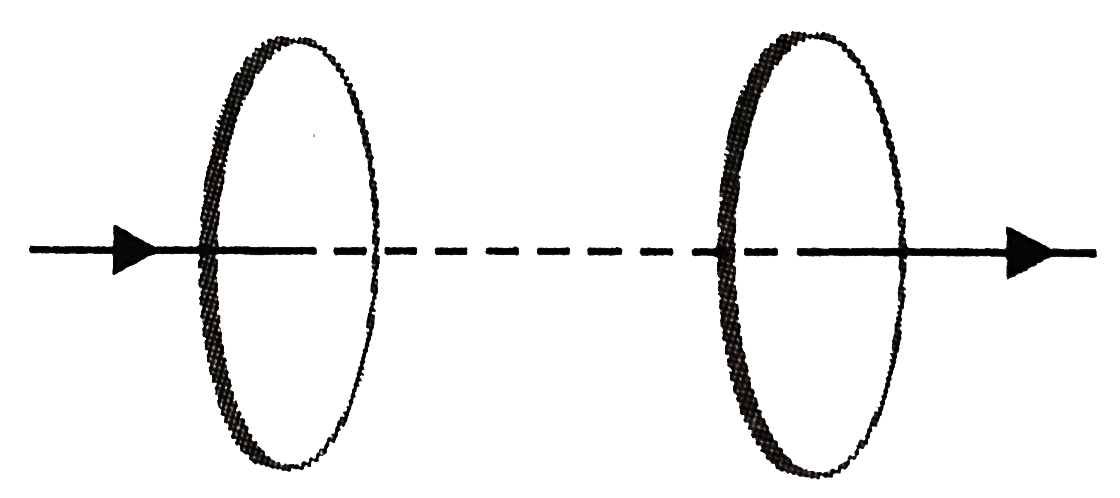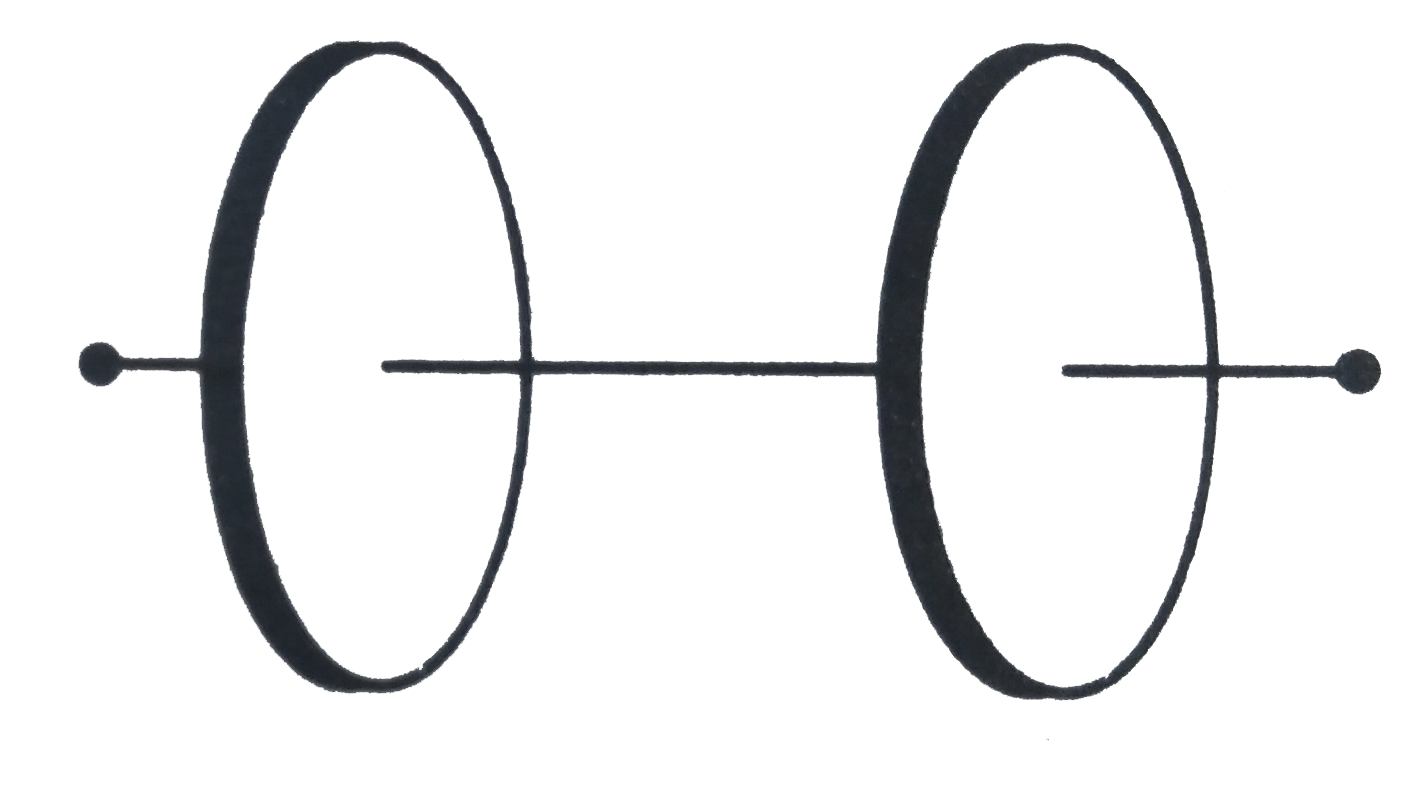Fig. shows a capacitor made of two circular plates each of radius 12 cm and separated by 5.0 cm. The capacitor is being charged by an external source (not shown in the figure). The charging current is constant and equal to 0.15A.
(a) Calculate the capacitance and the rate of change of potential difference between the plates.
(b) Obtain the displacement current across the plates.
(c) Is Kirchhoff's first rule valid at each plate of the capacitor ? Explain.

Radius of each circular plate, r=12cm =0.12m
Distance between the plates, d=5cm=0.05m
Changing current, I=0.15A
permittivity of free space, ε0=3.85×10−12C2N−1m−2
(a) Capacitance between the two plates is given by the relation
=ε0Ad
C
where A=Area of each plate =πr2
C=ε0πr2d
=8.85×10π12×0.1220.05
=8.0032×10−12F=80.032pF
Charge on each plate, q=CV
Where,
V=potential difference across the plates
Differentiation on both sides with respect to time (t) gives :
dqdt=CdVdt
But, Dqdt=current(l)
∴dvdt=1C
⇒0.1580.032×10−12=1.87×109V/s
Therefore, the change in potential difference between the plates is 1.87×109V/s.
(b) The displacement current across the plates is the same as the conduction current.
Hence, the displacement current ,id is 0.15A.
(c) Yes
Kirchhoff's first rule is valid at each plate of the capacitor provided that we take the sum of conduction and displacement for current.
Topper's Solved these Questions
Similar Questions
Figure 8.01 shows a capacitor made of two circular plates each of radius 12 cm, and separated by 5.0 cm. The capacitor is being charged by an external source (not shown in the figure). The charging current is constant and equal to 0.15 A.
(a) Calculate the capacitance and the rate of charge of potential difference between the plates.
(b) Obtain the displacement current across the plates.
(c) Is Kirchhoff.s first rule (junction rule) valid at each plate of the capacitor? Explain.
 View Solution
View SolutionFigure shows a capacitor made of two circular plates each of radius 12cm, and separated by 5.0cm. the capacitor is being charged by an external source (not shown in the figure). The charging current is constant and equal to 0.15A
(a) Calcuate the capacitance and the rate of change of potential difference between the plates
(b) Obtain the displacement current across the plates
(c) Is kirchhoff's first rule(junction rule) vaild at each plate of the capacitor ? Explain.
 .View Solution
.View Solution
Knowledge Check
- Question 1 - Select One
A capacitor made of two circular plates each of radius 12 cm and separated by 5 mm. The capacitor is being charged by an external source. The charging current is constant and equal to 0.15 A. The capacitance of the parallel plate capacitor is
 A40 pFB45 pFC70 pFD80 pF
A40 pFB45 pFC70 pFD80 pF - Question 2 - Select One
A parallel plate capacitor consists of two circular plates each of radius 12cm and separated by 5.0mm. The capacitor is being charge by an external source. The charging current is constant and is equal to 0.15 A. The rate of change of potential difference between the plate will be
A8.173×107Vs−1B7.817×108Vs−1C1.173×109Vc−1D3.781×1010Vs−1
A parallel plate capacitor made of two circular plates each of radius 10 cm and separated by 4.0mm. The capacitor is being charged by an external source. The charging current is constant and equal to 0.10A. Calculate (i) the capacitance (ii) the rate of change of potential difference between the plates (iii) the displacement current.
View SolutionA capacitor consists of two circular plates each of radius 8.0 cm and separated by 3.0 mm. The capacitor is being charged by an external battery. The charging current is constant and is equal to 0.3 A. Calculate (i) capacitance of capacitor, (ii) the rate of change of potential difference across the plates of capacitor and (iii) the displacement current.
View Solution(a) Fig shows a capacitor made of two circular plates each of radius 12cm and separated by 5.0mm. The capacitor is being charged by an external source (not shown in the figure). The charging current is constant and equal to 0.15A. Use Ampere's law (modified to include displacement current as given in the text) and the symmetryin the problem to calculate magnetic field between the plates at a point (i) on the axis (ii) 6.5 cm from the axis (iii) 15cm from the axis.
(b) At what distance from the axis is the magnetic field due to displacement current greatest? Obtain the maximum value of the field. View Solution
View SolutionA capacitor, made of two parallel plates each of plate area A and separation d, is being charged by an external ac socurce. Show that the displacement current inside the same as the current charging the capacitor.
View SolutionA parallel plate capacitor has two circular plates each of radius 5 cm separated by a distance of 3 m m . The capacitor current of 6 A is delived to it , find
(a) The capacitance
(b ) The rate of change of potential difference across the plates
(c ) the displacement current .View SolutionCalculate the rate of change in the potential difference between the parallel plates of a 1μF capacitor to develop an instantaneous displacement current of 0.5 A .
View Solution

